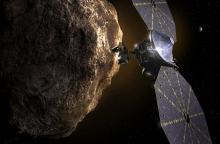Listen to today's episode of StarDate on the web the same day it airs in high-quality streaming audio without any extra ads or announcements. Choose a $8 one-month pass, or listen every day for a year for just $30.
You are here
Moon and Jupiter
A day after covering up Mars, the crescent Moon takes aim at another planet: Jupiter, the giant of the solar system. They’ll be low in the southeast at first light tomorrow. Jupiter looks like a brilliant star. This time, though, the Moon won’t quite catch up to it — they’ll stay a few degrees apart.
The Moon is actually on a sort of tour of the bright outer planets. Early today it passed by Mars, the fourth planet from the Sun. Tomorrow it’s Jupiter, the fifth planet. And on Thursday it’ll stand near Saturn, the sixth planet.
The fact that the three of them line up in order, and fairly equally spaced, is a result of their clock-like procession around the Sun.
Each planet moves at its own pace. Mars, for example, loops through the background of stars in about two years. Jupiter takes about 12 years to make that same circuit, while Saturn takes almost 30 years.
The difference is a result of their distances from the Sun. A planet that’s farther from the Sun has to cover a greater distance than one that’s closer — like being in the outer lane of a race track. And thanks to the laws of orbital motion, a more-distant planet moves more slowly than a closer one.
Over the coming weeks, the grouping of Mars, Jupiter, and Saturn will get even tighter. Mars will pass by both worlds in March. And Jupiter and Saturn will draw tighter through the spring — before they begin to pull apart in summer.
We’ll have more about the Moon and Saturn tomorrow.
Script by Damond Benningfield





